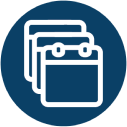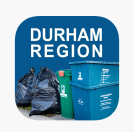Welcome to the Online Meeting for the Durham Long-term Waste Management Plan (Waste Plan)
Durham Region Virtual Engagement
Thank you for participating in our second online engagement event for the Waste Plan. The entire session should take about 10-15 minutes to complete, including a short survey at the end. We look forward to receiving your input and continuing to work with you throughout the development of the Waste Plan.
We want to hear from you about the Waste Plan!
You can click here to give us your feedback now, or you can read through the presentation and complete the survey.
How to Navigate
- Click on the arrows at the bottom of your screen
- Use the navigation bar at left of your screen to revisit any part of the meeting
- Click on the drop-down arrows to see a full list of actions
This presentation will be available throughout the development of the Waste Plan, but the survey will only be open from September 21 to October 25, 2021.
About the Waste Plan Development
In 2020
 Over 13,000 residents visited the online consultation in 2020 with 2,098 completing the survey
Over 13,000 residents visited the online consultation in 2020 with 2,098 completing the survey We consulted with Regional and Local Area Municipality staff and Regional Committees resulting in over 100 contacts and 26 surveys
We consulted with Regional and Local Area Municipality staff and Regional Committees resulting in over 100 contacts and 26 surveys A project website and newspaper and radio ad campaign resulted in almost 2 million website pageviews
A project website and newspaper and radio ad campaign resulted in almost 2 million website pageviews Social media and Waste App alerts reached 79,000 new users
Social media and Waste App alerts reached 79,000 new users Over 300 residents participated in the Virtual Town Hall
Over 300 residents participated in the Virtual Town Hall As a result of consultation, we added a new guiding principle and revised the vision statement; we also added an objective to emphasize the importance of rethinking and reducing waste as the first step of waste management
As a result of consultation, we added a new guiding principle and revised the vision statement; we also added an objective to emphasize the importance of rethinking and reducing waste as the first step of waste management
In 2021
 2,570 residents took the spring 2021 survey
2,570 residents took the spring 2021 survey Council approved the Waste Plan Guiding Principles, Vision and Objectives
Council approved the Waste Plan Guiding Principles, Vision and Objectives We developed Draft Actions and Targets
We developed Draft Actions and Targets We consulted with Regional and Local Area Municipality staff and Regional Committees on the Draft Waste Plan and Draft Actions and Targets
We consulted with Regional and Local Area Municipality staff and Regional Committees on the Draft Waste Plan and Draft Actions and Targets We’re consulting on the Draft Actions and Targets through this online meeting and survey. Note that we have presented a simplified version here, but the full wording can be found in the Draft Waste Plan.
We’re consulting on the Draft Actions and Targets through this online meeting and survey. Note that we have presented a simplified version here, but the full wording can be found in the Draft Waste Plan. A Virtual Town Hall will be held on October 19, 2021 – keep a look out for an announcement!
A Virtual Town Hall will be held on October 19, 2021 – keep a look out for an announcement! We’ll incorporate the feedback received into the Waste Plan to be presented to Council in early 2022
We’ll incorporate the feedback received into the Waste Plan to be presented to Council in early 2022
Guiding Principles, Vision and Objectives
In January 2021, Council approved the Waste Plan Guiding Principles, Vision and Objectives
 Approved Guiding Principles
Approved Guiding Principles
- Emphasize rethink, reduce and reuse principles as the first steps in reducing waste generation
- Deliver cost effective waste management services to a rapidly growing and diverse population
- Work with producers and importers of designated products and packaging to implement “Extended Producer Responsibility” and adjust Region waste programs as required
- Apply innovative approaches to Region waste streams to manage them as resources in a circular economy
- Demonstrate leadership in sustainability to address the climate crisis by reducing greenhouse gas emissions from waste management activities
 Approved Vision
Approved Vision
Together, with our residents, we will reduce the amount of waste we create and manage the generated waste as a resource. We will build an innovative system, balancing financial needs and environmental sustainability.
 Approved Objectives
Approved Objectives
Objective 1:
Engage with residents to build an understanding and awareness of the 5Rs (Rethink, Reduce, Reuse, Recycle, Recover) and the Region’s waste management programs and services
Objective 2:
Reduce the quantity of waste we create
Objective 3:
Increase diversion of waste from disposal and support the circular economy
Objective 4:
Support the Region’s greenhouse gas reduction and climate change mitigation efforts
Objective 5:
Protect or improve water, land, and air quality in Durham Region
Draft Targets and Actions
Draft targets, measurements and actions have been developed.
The Waste Plan consists of:
-
 Targets that have been developed to meet the objectives
Targets that have been developed to meet the objectives
-
 Measurements that have been identified to assess the progress of meeting the targets
Measurements that have been identified to assess the progress of meeting the targets
-
 Actions that have been developed for the Region and our community to contribute to meeting the targets
Actions that have been developed for the Region and our community to contribute to meeting the targets
Timelines for actions:
-
 Short-term (2022-2026)
Short-term (2022-2026)
-
 Mid-term (2027-2033)
Mid-term (2027-2033)
-
 Long-term (2034-2040)
Long-term (2034-2040)
Objective 1
Engage with residents to build an understanding and awareness of the 5Rs and the Region’s waste management programs and services
This objective is to help residents understand how they can reduce waste by making different purchasing decisions (i.e. Do I want this or need this? Or can I buy this used or borrow one?). We also want to make sure all residents know about the waste reduction and recycling programs the Region already offers.
Click the arrows below to see the full list of Actions.

Target 1A:
Increase public engagement on the 5Rs through partnerships, increased accessibility, and different media

Measurements:
Year over year increase (from 2018 or action start date)

- 1A1: Work with schools to provide educational content and increase rethink and reduce activities
- 1A2: Transition to a central access point for residents to obtain waste management information (e.g., myDurham311)
- 1A3: Increase Waste app subscribers
- 1A4: Add a dedicated section to the Region’s webpage on Reduction and Reuse
- 1A5: Investigate the feasibility of including locations of donation centres on the Waste app
- 1A6: Develop digital and/or in-person educational opportunities such as online meetings, how-to videos, tours of waste management facilities, potentially through investigating collaborations with community groups
- 1A7: Identify additional languages for publications, promotion and education materials and outreach events such as multi-cultural groups and clubs
- 1A1: # of classrooms using Region content
- 1A2: # of contacts regarding waste management handled by myDurham311
- 1A3: # of subscribers
- 1A4: # of visits to webpages
- 1A5: Evaluation of technical feasibility of enhancements
- 1A6: # of views, # of meetings and/or tours, # of people attending meetings and/or tours
- 1A7: Increased number of languages available

Objective 2
Reduce the quantity of waste we create
This objective is about the importance of the changes that residents can make to create less waste. This is the reduce part of the 5Rs.
We are seeking input on what a reasonable goal is for reduction in garbage disposed per person over the next twenty years.
Click the arrows below to see the full list of Actions.

Target 2A:
Support residents in making behavioural changes to reduce food waste

Measurements:
Reduce quantities of food waste

- 2A1: Continue with the Region’s “Buy it, Eat it” food waste reduction campaign

Target 2B:
Support residents in making behavioural changes to reduce the amount of waste generated

Measurements:
Reduce quantities of materials generated such as durable goods, textiles and single-use plastics

- 2B1: Measure annual generation rates of garbage and organics to track progress in reducing waste
- 2B2: Develop a monitoring program to measure waste collected and waste composition on a regular basis
- 2B3: Evaluate partnerships with local charities on common messaging, sharing libraries and other circular economy opportunities
- 2B4: Partner with local area municipalities on common messaging and approach to textile diversion, single use items, etc.

Objective 3
Increase diversion of waste from disposal and support the circular economy
This objective is about not sending as much waste to disposal through new programs that divert more waste.
Click the arrows below to see the full list of Actions.

Target 3A:
Increase diversion of organics from disposal

Measurements:
Increase organics diversion

- 3A1: Develop the Mixed Waste Pre-sort and Anaerobic Digestion Facility to divert organics from garbage
- 3A2: Launch an enhanced Green Bin program for single-family residences
- 3A3: Encourage backyard composting
- 3A4: Expand collection services to more Regional facilities such as long-term care homes to divert more organics
- 3A5: Expand collection services to more multi-residential buildings to divert more material

Target 3B:
Revise Waste Management By-law 46-2011 to reflect changes to Regional collection and processing programs and services

Measurements:
Revise By-law by 2026

- 3B1: Revise By-law to reflect new Extended Producer Responsibility (EPR) programs for recycling, electronics, household hazardous waste, batteries, etc.
- 3B2: Revise By-law to include a new section for the Mixed Waste Pre-sort and Anaerobic Digestion Facility and its operation/use
- 3B3: Review options to collect waste in denser developments (e.g., smaller trucks, different collection containers, collection on one side of street, central collection areas etc.)

Objective 3
Increase diversion of waste from disposal and support the circular economy
This objective is about not sending as much waste to disposal through new programs that divert more waste.
Click the arrows below to see the full list of Actions.

Target 3C:
Develop a transition plan that supports EPR programs

Measurements:
Successful transition to EPR in 2024

- 3C1: Work with producers to understand how programs will be rolled out and the impact on the Region
- 3C2: Develop educational campaigns to inform residents of changes to programs
- 3C3: Transition the program(s) to producers and make any required modifications to areas remaining under the Region’s responsibilities.
- 3C4: Explore opportunities to reuse or recycle household hazardous waste not covered under the regulations (e.g., refillable propane cylinders, or fertilizer)
- 3C5: Assess options for the Region’s recycling facility and equipment
- 3C6: Evaluate if changes are required at Waste Management Facilities to adapt to EPR regulations
- 3C7: Evaluate if the Region will continue to provide recycling collection service to ineligible sources (e.g., small businesses in BIAs and other small businesses currently serviced in the curbside collection program)
What is EPR?
EPR stands for Extended Producer Responsibility. The objective of these regulations is to shift the responsibility for designated recyclable materials (this includes financial, operational and regulatory responsibilities) from municipalities to producers of the materials and encourage producers to invest towards improving their products and packaging through product design.
Who are producers?
Producers (brand-owners, importers, marketers of products in Ontario) will be responsible for managing designated materials (e.g., paper products, packaging, packaging-like products, used tires, electronics and household hazardous waste). Producers will work with Producer Responsibility Organizations (PROs) to manage these materials and ensure the provincially mandated recovery targets are met.

Objective 3
Increase diversion of waste from disposal and support the circular economy
This objective is about not sending as much waste to disposal through new programs that divert more waste.
Click the arrows below to see the full list of Actions.

Target 3D:
Advocate for the expansion of existing EPR programs and for additional EPR programs to manage more materials

Measurements:
Number of advocacy efforts (e.g., letters, conversations, participation in related webinars/feedback sessions) towards new or expanded EPR programs for materials such as compostable packaging, mattresses, carpets, furniture, appliances, textiles, hard plastics, fertilizers, appliances, etc.

- 3D1: Continue to participate in the solid waste management committees of municipal advocacy organizations
- 3D2: Continue to participate in consultation opportunities for proposed Federal and Provincial waste management changes
- 3D3: Advocate to the Federal and Provincial governments for new EPR programs to divert more materials from disposal
- 3D4: Advocate for existing programs to be expanded (e.g., recycling, hazardous waste, electronics)
- 3D5: Provide comments on any proposed EPR programs to ensure Durham Region’s considerations are included in the development of regulations

Objective 4
Support the Region’s greenhouse gas (GHG) reduction and climate change mitigation efforts
This objective is about finding ways to reduce greenhouse gas emissions from waste management activities.
Click the arrows below to see the full list of Actions.

Target 4A:
Develop initiatives to offset or reduce GHG emissions from solid waste that contribute to Corporate GHG emissions

Measurements:
Annual actions to implement initiatives to reduce GHG emissions to contribute to the Corporate GHG emissions reduction target of 40 per cent below 2019 levels by 2030 (and 100 per cent below 2019 levels by 2045)

- 4A1: Explore opportunities to convert collection vehicles to use alternative fuels
- 4A2: Identify opportunities to convert biogas to Renewable Natural Gas (RNG) at Region-owned facilities
- 4A3: Identify additional methodologies to determine GHG emission reductions and avoidance associated with waste reduction, reuse, recycling and recovery that are not currently reflected in the Corporate GHG inventory
- 4A4: Undertake additional analyses to review how to better recover energy resources from waste operations
- 4A5: Develop a carbon emissions management plan in partnership with the Region’s Sustainability group
- 4A6: Work with other Divisions (e.g., Purchasing, Facilities, Legal, Sustainability Office) to leverage the Region’s buying power to develop in-house circular economy initiatives
- 4A7: Explore options for wind/solar installations at Waste Management Facilities (WMFs)
- 4A8: Explore opportunities to convert some or all fleet vehicles to alternative fuels
- 4A9: Assess operational practices (e.g., compaction, transfer) at WMFs that would reduce emissions from transportation

Objective 5
Protect or improve water, land and air quality in Durham Region
This objective is to make it easier for people to use WMFs to reduce illegal dumping and proper disposal of waste which protects our water, land and air.
Click the arrows below to see the full list of Actions.

Target 5A:
Optimize the operation and utilization of Waste Management Facilities (WMFs)

Measurements:
Annual actions to optimize operations at WMFs

- 5A1: Explore options to optimize the Oshawa WMF (e.g., traffic flow, new indoor/outdoor facility)
- 5A2: Investigate options to improve diversion at WMFs (e.g., fertilizer reuse, bulky plastics recycling, separation of renovation/construction materials)
- 5A3: Explore options to optimize Brock and Scugog WMFs (similar to Oshawa WMF)
- 5A4: Evaluate business case to develop a new WMF or smaller drop-off depots with consideration to under-serviced areas

Target 5B:
Increase accessibility of waste management programs and services

Measurements:
Changes to operating hours and physical accessibility of WMFs

- 5B1: Investigate extending the hours of operation (e.g., open later in the evening, different/more days, seasonal hours) to make access to the WMFs more convenient for users
- 5B2: Assess accessibility of WMFs (e.g., signage, access to containers, stairs, ramps etc.) to ensure they are physically accessible.
- 5B3: Explore options for assisted waste collection to help residents manage set out of materials

Objective 5
Protect or improve water, land and air quality in Durham Region
This objective is to make it easier for people to use WMFs to reduce illegal dumping and proper disposal of waste which protects our water, land and air.
Click the arrows below to see the full list of Actions.

Target 5C:
Explore options to reduce environmental impacts of closed landfills and potential for future community use

Measurements:
Annual progress towards implementing alternative landfill cover systems at closed landfills and conversion for community use

- 5C1: Maintain current landfill monitoring and ongoing care program while evaluating additional options to minimize landfill GHG generation and other environmental impacts
- 5C2: Evaluate outcome of pilot project at Oshawa Landfill for an alternative landfill cover system to reduce methane emissions
- 5C3: Based on the outcome of the Oshawa Landfill pilot project, evaluate potential to implement the alternative cover system at other Region-owned closed landfills
- 5C4: Explore options to install solar covers at closed landfills
- 5C5: Evaluate potential to utilize closed landfills for community use

New Waste Plan: Next Steps
Thank you for visiting our online meeting!
The comment period for this online meeting will close on October 25, 2021
Fall 2021
We’ll summarize feedback from this online meeting
Fall 2021
We’ll be considering the feedback and preparing the final Waste Plan and Five-Year Action Plan
Early 2022
We’ll present to Council for approval and then start implementing the Actions
We want to hear from you!
Click here to take the survey now!For More Information
Follow us on social media for updates
Reach us at
WastePlan@Durham.ca Subscribe to our webpage
Durham.ca/WastePlan
Join us at the Virtual Town Hall on October 19, 2021 Keep a look out for an announcement.

Download the Durham Region Waste App!
 Available on the App Store
Available on the App Store
 Available in the Google Play Store
Available in the Google Play Store
The Apple logo and App Store logo are trademarks of Apple Inc.
Google Play and the Google Play logo are trademarks of Google LLC.